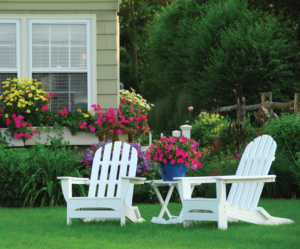 Mowing Lawns in the Summer– In the spring and fall, when nights are cool and grass grows well, lawns should be mowed at a height of 3-3 ½” (depending on how often you mow). Lawns should be mowed often enough that you’re not removing more than 1/3 of the length of the blade, and often enough that you’re not leaving clumps of grass on the lawn. Longer blade length allows us to go as long as 5-7 days between cuts, and the 3-3 ½’ height makes the lawn look lush while still allowing moisture to evaporate or percolate. When we get to summer, and both daytime and nighttime temperatures are considerable higher, grass plants will not produce roots; there can be some root dieback in extreme conditions. Thus, we want you to raise mower decks to 4+ inches. The longer grass blade will shade or protect vulnerable plant crowns and the lawn will hold its color longer in the heat. In addition, you should extend the gap between mowings (depending on moisture and its effect on rates of growth) to a week or more.
Mowing Lawns in the Summer– In the spring and fall, when nights are cool and grass grows well, lawns should be mowed at a height of 3-3 ½” (depending on how often you mow). Lawns should be mowed often enough that you’re not removing more than 1/3 of the length of the blade, and often enough that you’re not leaving clumps of grass on the lawn. Longer blade length allows us to go as long as 5-7 days between cuts, and the 3-3 ½’ height makes the lawn look lush while still allowing moisture to evaporate or percolate. When we get to summer, and both daytime and nighttime temperatures are considerable higher, grass plants will not produce roots; there can be some root dieback in extreme conditions. Thus, we want you to raise mower decks to 4+ inches. The longer grass blade will shade or protect vulnerable plant crowns and the lawn will hold its color longer in the heat. In addition, you should extend the gap between mowings (depending on moisture and its effect on rates of growth) to a week or more.
Watering Lawns in the Summer– Our lawns are comprised of cool season grasses. They’ll slow down their rate of growth in typical summer weather. This is good. Because they can’t produce roots in the warm soil, continued growth creates stressful growing conditions. We can’t control what Mother Nature gives us in the way of summer moisture, but we can certainly control what supplemental irrigating we do. Our advice is to water only when the grass is showing signs of wilt (bluish, gray color to the lawn & grass blades don’t bounce back up when the lawn is walked on). This will be an indication of dry growing conditions. Further,ALWAYS WATER LAWNS IN THE EARLYMORINING finishing watering by 8AM. Watering later than 8am in the morning or watering in the early evening, extends (lengthens) the period of time grass is wet, which will bring on turf disease. Watering during the heat of the day is wasteful, losing much of the water to evaporation. If you’ve got a new or immature lawn (less than 1-2 years established), supplemental summer irrigation is much more important. Younger grass does not have as strong a root system as established grass, and should be watered during times of extended dry and hot summer weather. Remember to water deeply (up to 1 hour per area), but less frequently (every 7-14 days without beneficial rainfall).
Fertilizing Lawns in June– We recommend that lawns be fed 4 times a year: early spring, late spring, early fall, and late fall, just before winter dormancy. Most lawns have not been fed since April at this time. Because of the significant spring growth, lawns are now pretty well out of fuel. The turf food we recommend for early summer is a slow-release, organic-based nitrogen fertilizer. It will subtly green the lawn without stimulating significant top growth.
Broadleaf Weed Control in June– Hopefully, those of you who had lots of weeds in your lawns this spring have already taken care of removing them with an application of liquid TRIMEC herbicide. The primary targets of our early spring weed frustration are dandelions, which begin growing actively in early April. But many lawns are infested with other, later starting, warm-weather perennial weeds, such as clover, plantain, oxalis, wild strawberries, and others. If you notice an encroachment of broadleaf weeds now, they are easy to get rid of with a single TRIMEC application at this time. Be sure when you apply TRIMEC that the air temperature at the time of application is not above 85 degrees, and that rain is not in the forecast. And, as I always remind you, the best time to eliminate weeds from your lawns is September or early October, at the end of the active growing season for most weeds. If you want a weed-free lawn in the spring, make an application with TRIMEC in early fall.
Nutsedge Control in Lawns and Beds– Yellow Nutsedge is actually a sedge, not a grass or broadleaf weed. It is yellow-green, grows in both lawns (particularly in low or wet areas) and planting beds. It is a perennial weed and spreads by underground nutlets (left from prior year’s plants) and rhizomes. Nutsedge is controllable, but it’s difficult. Distinctively faster growing than grass, with a triangular stem, nutsedge MUST be sprayed soon after it sprouts or it will spread with a vengeance. The only way to really gain control over nutsedge is to spot treat it whenever you see it with either PROSEDGE or SEDGE ENDER herbicide, both of which are sold at The Lawn Depot. Nutsedge is NOT controlled with TRIMEC, or any other broadleaf herbicide.
Grub Control with Season Long MALLET– Grubs are the larval stage of many insects that are better known in their adult stage, like Japanese beetles and others. The adults annoy for a few summer weeks and are gone. Seldom is there any permanent damage done to shrubs, trees and/or flowers. Grubs, however actively feed on the shallow roots of turfgrasses from late August until late fall, and again in the spring from April into June. Grubs can devastate beautiful lawns if they are left unchecked for a feeding season. And the real issue is that you never see them feeding until it’s too late and sections of turf simply die. We urge you to consider annual treatments with MALLET grub control. Apply in the spring (May-June), water in thoroughly, and rest assured that your lawn will be safe from grub damage through the end of the growing season. MALLET is available with or without slow-release, organic-based nitrogen fertilizer.
Post-Emergence Crabgrass Control– If you didn’t apply DIMENSION pre-emergence crabgrass control in April or May, or if you notice that you may have missed an area and you have some crabgrass breakthrough along streets, driveways or other areas where the turf is weak, we have POST-EMERGENCE CRABGRASS CONTROL that is easy to use and very effective. You can treat larger areas or spot treat as needed.
